Related compounds Molar mass 61.83 g/mol Density 1.44 g/cm³ Soluble in Water | Formula H3BO3 Melting point 170.9 °C Boiling point 300 °C | |
 | ||
Appearance White crystalline solid Thermodynamicdata Phase behavioursolid–liquid–gas IUPAC ID Trihydrooxidoboron, Boric acid | ||
Boric acid, also called hydrogen borate, boracic acid, orthoboric acid and acidum boricum, is a weak, monobasic Lewis acid of boron often used as an antiseptic, insecticide, flame retardant, neutron absorber, or precursor to other chemical compounds. It has the chemical formula H3BO3 (sometimes written B(OH)3), and exists in the form of colorless crystals or a white powder that dissolves in water. When occurring as a mineral, it is called sassolite.
Contents
- Ortho boric acid for class xi class xii jee main jee advance aipmt
- Occurrence
- Preparation
- Properties
- Reactions
- Molecular and crystal structure
- Toxicology
- Industrial
- Medical
- Insecticidal
- Preservation
- pH buffer
- Lubrication
- Nuclear power
- Pyrotechnics
- Agriculture
- Recreational
- References
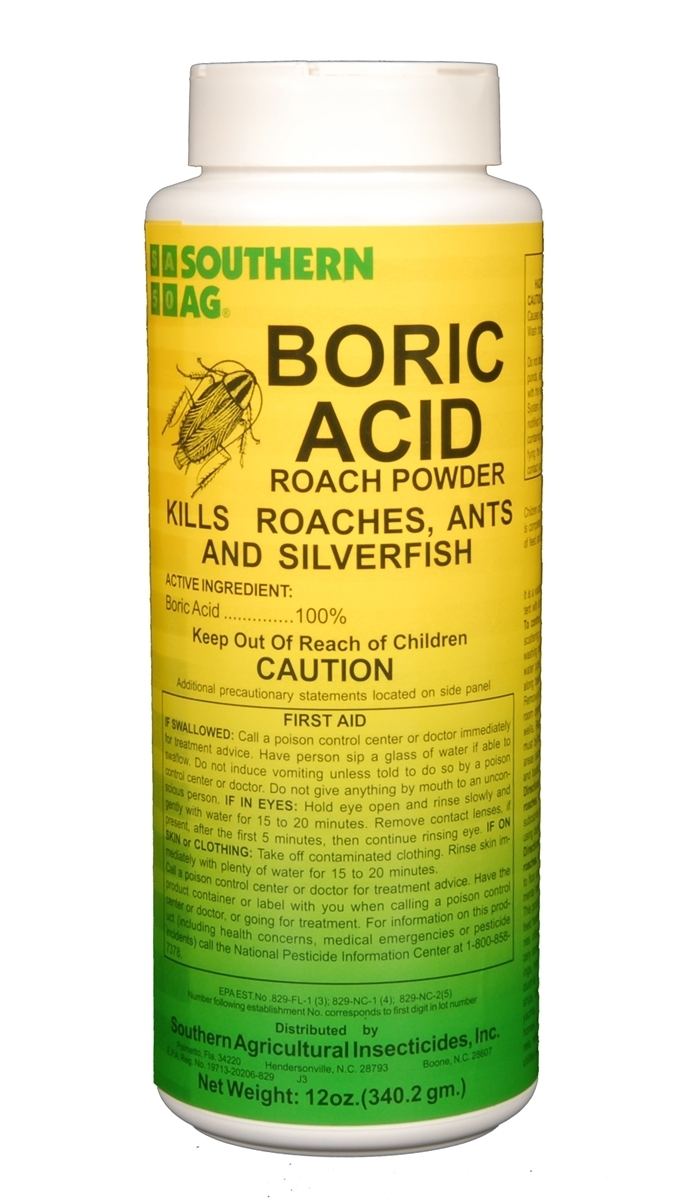
Ortho boric acid for class xi class xii jee main jee advance aipmt
Occurrence
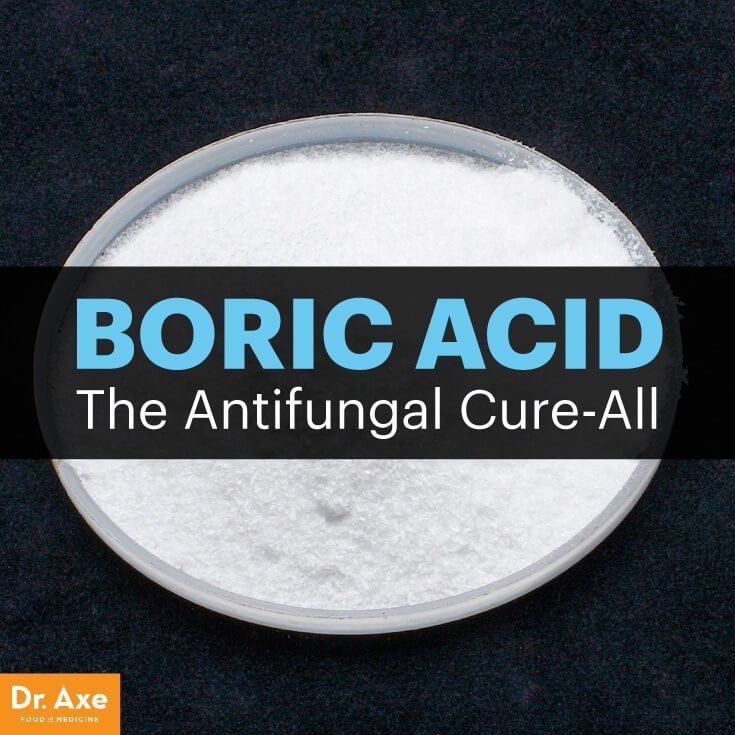
Boric acid, or sassolite, is found mainly in its free state in some volcanic districts, for example, in the Italian region of Tuscany, the Lipari Islands and the US state of Nevada. In these volcanic settings it issues, mixed with steam, from fissures in the ground. It is also found as a constituent of many naturally occurring minerals – borax, boracite, ulexite (boronatrocalcite) and colemanite. Boric acid and its salts are found in seawater. It is also found in plants, including almost all fruits.

Boric acid was first prepared by Wilhelm Homberg (1652–1715) from borax, by the action of mineral acids, and was given the name sal sedativum Hombergi ("sedative salt of Homberg"). However borates, including boric acid, have been used since the time of the Greeks for cleaning, preserving food, and other activities.
Preparation

Boric acid may be prepared by reacting borax (sodium tetraborate decahydrate) with a mineral acid, such as hydrochloric acid:
Na2B4O7·10H2O + 2 HCl → 4 B(OH)3 [or H3BO3] + 2 NaCl + 5 H2OIt is also formed as a by product of hydrolysis of boron trihalides and diborane:
B2H6 + 6 H2O → 2 B(OH)3 + 6 H2BX3 + 3 H2O → B(OH)3 + 3 HX (X = Cl, Br, I)Properties
Boric acid is soluble in boiling water. When heated above 170 °C, it dehydrates, forming metaboric acid (HBO2):
H3BO3 → HBO2 + H2O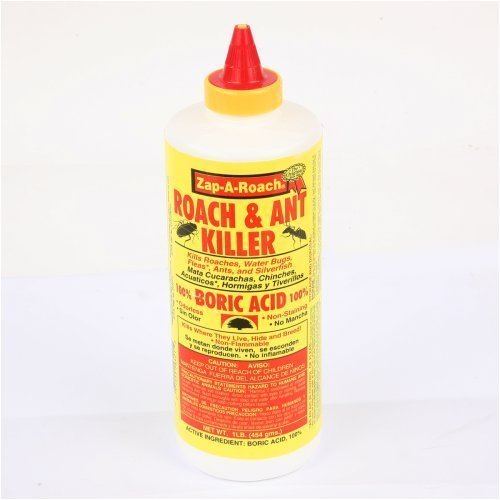
Metaboric acid is a white, cubic crystalline solid and is only slightly soluble in water. Metaboric acid melts at about 236 °C, and when heated above about 300 °C further dehydrates, forming tetraboric acid or pyroboric acid (H2B4O7):
4 HBO2 → H2B4O7 + H2OThe term boric acid may sometimes refer to any of these compounds. Further heating leads to boron trioxide.
H2B4O7 → 2 B2O3 + H2O
There are conflicting interpretations for the origin of the acidity of aqueous boric acid solutions. Raman spectroscopy of strongly alkaline solutions has shown the presence of B(OH)−
4 ion, leading some to conclude that the acidity is exclusively due to the abstraction of OH− from water:
4 + H+ (K = 7.3x10−10; pK = 9.14)
or more properly expressed in the aqueous solution:
B(OH)3 + 2 H2O4 + H3O+
This may be characterized as Lewis acidity of boron toward OH−, rather than as Brønsted acidity.
However other sources say that boric acid is also a tribasic Brønsted acid, with successive ionization steps:
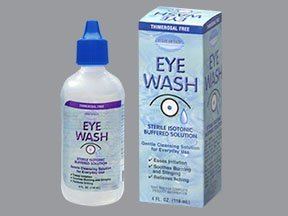
2 + H+ (Ka1 = 5.8x10−10; pKa1 = 9.24)BO(OH)−
2
3 + H+ (Ka3 = 4x10−14; pKa3 = 13.3)

Since the value of Ka1 is comparable to that of the reaction with OH−, the concentrations of BO(OH)−
2 and B(OH)−
4 are similar.
Polyborate anions are formed at pH 7–10 if the boron concentration is higher than about 0.025 mol/L. The best known of these is the 'tetraborate' ion, found in the mineral borax:
4[B(OH)4]− + 2H+ ⇌ [B4O5(OH)4]2− + 7H2OBoric acid makes an important contribution to the absorption of low frequency sound in seawater.
Reactions
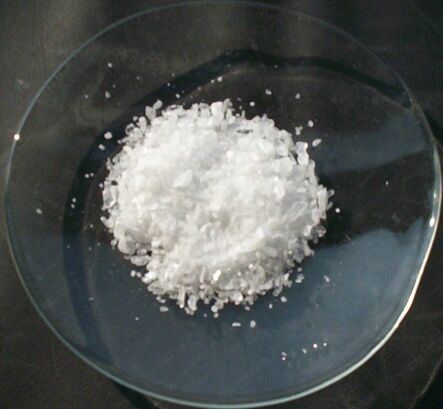
With polyols such as glycerol and mannitol the acidity of the solution is increased. With mannitol for example the pK decreases to 5.15. This is due to the formation of a chelate, [((OH)4C6H8O2)2B]−, and this feature is used in analytical chemistry.
Boric acid dissolves in anhydrous sulfuric acid:
B(OH)3 + 6H2SO4 → 3H3O+ + 2HSO4− + B(HSO4)4−Boric acid reacts with alcohols to form borate esters, B(OR)3 where R is alkyl or aryl. A dehydrating agent, such as concentrated sulfuric acid is typically added:
B(OH)3 + 3 ROH → B(OR)3 +3 H2OMolecular and crystal structure
The three oxygen atoms form a trigonal planar geometry around the boron. The B-O bond length is 136 pm and the O-H is 97 pm. The molecular point group is C3h.
Crystalline boric acid consists of layers of B(OH)3 molecules held together by hydrogen bonds of length 272 pm. The distance between two adjacent layers is 318 pm.
Toxicology
Based on mammalian median lethal dose (LD50) rating of 2,660 mg/kg body mass, boric acid is only poisonous if taken internally or inhaled in large quantities. The Fourteenth Edition of the Merck Index indicates that the LD50 of boric acid is 5.14 g/kg for oral dosages given to rats, and that 5 to 20 g/kg has produced death in adult humans. For comparison's sake, the LD50 of salt is reported to be 3.75 g/kg in rats according to the Merck Index. Humans have been known to die from amounts only a small fraction of the LD50. "The minimal lethal dose of ingested boron (as boric acid) was reported to be 2–3 g in infants, 5–6 g in children, and 15–20 g in adults....However, a review of 784 human poisonings with boric acid (10–88 g) reported no fatalities, with 88% of cases being asymptomatic ", according to the Agency for Toxic Substances and Disease Registry.
Long term exposure to boric acid may be of more concern, causing kidney damage and eventually kidney failure (see links below). Although it does not appear to be carcinogenic, studies in dogs have reported testicular atrophy after exposure to 32 mg/kg bw/day for 90 days. This level is far lower than the LD50.
According to boric acid IUCLID Dataset published by the European Commission, boric acid in high doses shows significant developmental toxicity and teratogenicity in rabbit, rat, and mouse fetuses as well as cardiovascular defects, skeletal variations, mild kidney lesions. As a consequence, in August 2008, in the 30th ATP to EU directive 67/548/EEC, the EC decided to amend its classification as reprotoxic category 2 and to apply the risk phrases R60 (may impair fertility) and R61 (may cause harm to the unborn child).
At a recent European Diagnostics Manufacturing Association (EDMA) Meeting, several new additions to the Substance of Very High Concern (SVHC) candidate list in relation to the Registration, Evaluation, Authorisation and restriction of Chemicals Regulations 2007 (REACH) were discussed. The registration and review completed as part of REACH has meant the current classification of Boric Acid CAS 10043-35-3 / 11113-50-1 as of 1 December 2010 will be listed as H360FD (May damage fertility. May damage the unborn child.)
Industrial
The primary industrial use of boric acid is in the manufacture of monofilament fiberglass usually referred to as textile fiberglass. Textile fiberglass is used to reinforce plastics in applications that range from boats, to industrial piping to computer circuit boards.
In the jewelry industry, boric acid is often used in combination with denatured alcohol to reduce surface oxidation and firescale from forming on metals during annealing and soldering operations.
Boric acid is used in the production of the glass in LCD flat panel displays.
In electroplating, boric acid is used as part of some proprietary formulas. One such known formula calls for about a 1 to 10 ratio of H
3BO
3 to NiSO
4, a very small portion of sodium lauryl sulfate and a small portion of H
2SO
4.
Boric acid, mixed with borax (sodium tetraborate decahydrate) at the weight ratio of 4:5, is highly soluble in water, though they are not so soluble separately. The solution is used for fire retarding agent of wood by impregnation.
It is also used in the manufacturing of ramming mass, a fine silica-containing powder used for producing induction furnace linings and ceramics.
Boric acid is one of the most commonly used substances that can neutralize active hydrofluoric acid (HF). It works by forcing the free F− anions into complex salts. This process defeats the extreme toxicity of hydrofluoric acid, particularly its ability to sequester ionic calcium from blood serum which can lead to cardiac arrest and bone decomposition; such an event can occur from just minor skin contact with HF.
Boric acid is added to borax for use as welding flux by blacksmiths.
Boric acid, in combination with silicone oil, is used to manufacture Silly Putty.
Boric acid may be used in Marcellus Shale hydraulic fracturing in Pennsylvania.
Medical
Boric acid can be used as an antiseptic for minor burns or cuts and is sometimes used in dressings or salves. Boric acid is applied in a very dilute solution as an eye wash. Dilute boric acid can be used as a vaginal douche to treat bacterial vaginosis due to excessive alkalinity, as well as candidiasis due to non-albicans candida. As an antibacterial compound, boric acid can also be used as an acne treatment. It is also used as prevention of athlete's foot, by inserting powder in the socks or stockings, and in alcohol solution can be used to treat some kinds of otitis externa (ear infection) in both humans and animals. The preservative in urine sample bottles in the UK is boric acid.
Boric acid solutions used as an eye wash or on abraded skin are known to be toxic, particularly to infants, especially after repeated use; this is because of its slow elimination rate.
Insecticidal
Boric acid was first registered in the US as an insecticide in 1948 for control of cockroaches, termites, fire ants, fleas, silverfish, and many other insects. The product is generally considered to be safe to use in household kitchens to control cockroaches and ants. It acts as a stomach poison affecting the insects' metabolism, and the dry powder is abrasive to the insects' exoskeletons.
Preservation
In combination with its use as an insecticide, boric acid also prevents and destroys existing wet and dry rot in timbers. It can be used in combination with an ethylene glycol carrier to treat external wood against fungal and insect attack. It is possible to buy borate-impregnated rods for insertion into wood via drill holes where dampness and moisture is known to collect and sit. It is available in a gel form and injectable paste form for treating rot affected wood without the need to replace the timber. Concentrates of borate-based treatments can be used to prevent slime, mycelium, and algae growth, even in marine environments.
Boric acid is added to salt in the curing of cattle hides, calfskins, and sheepskins. This helps to control bacteria development, and helps to control insects.
pH buffer
Boric acid in equilibrium with its conjugate base the borate ion is widely used (in the concentration range 50 - 100 ppm boron equivalents) as a primary or adjunct pH buffer system in swimming pools. Boric acid is a weak acid, with pKa (the pH at which buffering is strongest because the free acid and borate ion are in equal concentrations) of 9.24 in pure water at 25 °C. But apparent pKa is substantially lower in swimming pool or ocean waters because of interactions with various other molecules in solution. It will be around 9.0 in a salt-water pool. No matter which form of soluble boron is added, within the acceptable range of pH and boron concentration for swimming pools, boric acid is the predominant form in aqueous solution, as shown in the accompanying figure. The boric acid - borate system can be useful as a primary buffer system (substituting for the bicarbonate system with pKa1 = 6.0 and pKa2 = 9.4 under typical salt-water pool conditions) in pools with salt-water chlorine generators that tend to show upward drift in pH from a working range of pH 7.5 - 8.2. Buffer capacity is greater against rising pH (towards the pKa around 9.0), as illustrated in the accompanying graph. The use of boric acid in this concentration range does not allow any reduction in free HOCl concentration needed for pool sanitation, but it may add marginally to the photo-protective effects of cyanuric acid and confer other benefits through anti-corrosive activity or perceived water softness, depending on overall pool solute composition.
Lubrication
Colloidal suspensions of nanoparticles of boric acid dissolved in petroleum or vegetable oil can form a remarkable lubricant on ceramic or metal surfaces with a coefficient of sliding friction that decreases with increasing pressure to a value ranging from 0.10 to 0.02. Self-lubricating H3BO3 films result from a spontaneous chemical reaction between water molecules and B2O3 coatings in a humid environment. In bulk-scale, an inverse relationship exists between friction coefficient and Hertzian contact pressure induced by applied load.
Boric acid is used to lubricate carrom and novuss boards, allowing for faster play.
Nuclear power
Boric acid is used in some nuclear power plants as a neutron poison. The boron in boric acid reduces the probability of thermal fission by absorbing some thermal neutrons. Fission chain reactions are generally driven by the probability that free neutrons will result in fission and is determined by the material and geometric properties of the reactor. Natural boron consists of approximately 20% boron-10 and 80% boron-11 isotopes. Boron-10 has a high cross-section for absorption of low energy (thermal) neutrons. By increasing boric acid concentration in the reactor coolant, the probability that a neutron will cause fission is reduced. Changes in boric acid concentration can effectively regulate the rate of fission taking place in the reactor. Boric acid is used only in pressurized water reactors (PWRs) whereas boiling water reactors (BWRs) employ control rod pattern and coolant flow for power control. BWRs use an aqueous solution of boric acid and borax or Sodium Pentaborate for an emergency shut down system. Boric acid may be dissolved in spent fuel pools used to store spent fuel elements. The concentration is high enough to keep neutron multiplication at a minimum. Boric acid was dumped over Reactor 4 of the Chernobyl Nuclear Power Plant after its meltdown to prevent another reaction from occurring.
Pyrotechnics
Boron is used in pyrotechnics to prevent the amide-forming reaction between aluminum and nitrates. A small amount of boric acid is added to the composition to neutralize alkaline amides that can react with the aluminum.
Boric acid can be used as a colorant to make fire green. For example, when dissolved in methanol it is popularly used by fire jugglers and fire spinners to create a deep green flame.
Agriculture
Boric acid is used to treat or prevent boron deficiencies in plants. It is also used in preservation of grains such as rice and wheat.
Recreational
For the game of carrom, boric acid is sprinkled onto the board of play to act as a dry lubricant to increase the speed of the pieces when struck.
